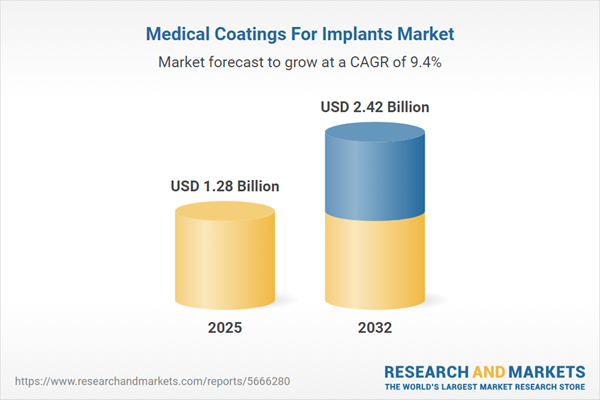Speak directly to the analyst to clarify any post sales queries you may have.
Medical coatings for implants are reshaping the medical device landscape by enhancing compliance, extending product lifespan, and driving operational efficiency. This evolution empowers device manufacturers to address regulatory shifts, optimize clinical performance, and establish product differentiation in a dynamic healthcare environment.
Market Snapshot: Medical Coatings for Implants
The global medical coatings for implants market displays consistent growth, buoyed by advances in surface technology and the increasing adoption of minimally invasive procedures. Significant demand is observed across orthopedic, dental, cardiovascular, and neurological device markets as healthcare providers and clinicians pursue sustainable solutions for patient safety and long-term device performance. The push for quicker patient recovery, extended service life of devices, and robust regulatory oversight has made advanced coatings a focal point for procurement and product development teams. Investments in surface engineering and stringent quality initiatives illustrate the industry’s ongoing commitment to enhancing functionality in high-pressure clinical settings.
Scope & Segmentation in the Medical Coatings for Implants Market
This report provides detailed segmentation, guiding R&D strategy, operational planning, and cross-functional compliance for stakeholders across the medical coatings for implants value chain.
- Coating Types: Covers antimicrobial coatings that reduce infection risks, bioactive and drug-eluting surfaces for improved tissue integration or focused therapy delivery, and durable ceramic, metallic, and polymer coatings engineered for rigorous clinical needs.
- Implant Types: Features cardiovascular, dental, neurological, orthopedic, and spinal devices leveraging coatings customized to meet specialty-specific compliance and durability challenges.
- Material Compositions: Includes advanced polymers, ceramic blends, metal matrices, and fiber composites, developed for both mechanical robustness and processability across varied surgical scenarios.
- Applications: Encompasses devices such as bone screws, joint replacements, heart valves, plates, and stents, where coatings play a significant role in speeding recovery times and reducing complications.
- Technologies: Highlights techniques like electrochemical and layered deposition, plasma spraying, and nanocoatings that enable tailored coating solutions and reinforce integrity on new-generation devices.
- Regions: The Americas, Europe, Middle East & Africa, and Asia-Pacific, each with unique adoption patterns shaped by healthcare infrastructure, demographics, and evolving local regulatory requirements.
- Key Companies: Profiles leading industry innovators including Koninklijke DSM N.V., Evonik Industries AG, SurModics, BioInteractions Limited, Covalon Technologies, Danaher Corporation, Johnson & Johnson Services, Medtronic, Stryker, and Zimmer Biomet Holdings.
Key Takeaways for Senior Decision-Makers
- Continuous innovation in coating technologies supports superior biocompatibility and efficient integration, helping manufacturers align with evolving clinical and regulatory expectations.
- Product customization and adaptable coatings are shaping procurement and operational strategies as demand for patient-specific devices grows.
- Cutting-edge techniques such as nanocoating and precision deposition enable compliance with new design requirements and keep pace with regulatory adjustments.
- Collaborative efforts among manufacturers, research institutions, and regulatory entities streamline validation processes and accelerate time-to-market for novel products.
- Distinct regional reimbursement and care models require organizations to develop tailored market entry and operational strategies to sustain competitiveness across multiple geographies.
- Wider adoption of digital supply chain monitoring and real-time analytics enhances regulatory responsiveness and agility in meeting new policy or client requirements.
Tariff Impact and Supply Chain Dynamics
Recent changes in U.S. tariff policy have increased costs for polymers, ceramics, and antimicrobial materials crucial to implant coatings. Organizations are now widening supplier networks and forming local partnerships to strengthen supply chain resilience. This approach demands reinforced oversight and expanded quality protocols to achieve regulatory compliance and uphold client standards in changing market conditions.
Methodology & Data Sources
Market insights have been derived through structured executive interviews with major implant device manufacturers and specialized research institutions. These findings are validated against peer-reviewed publications, international patent databases, and recent regulatory assessments to ensure accuracy and decision-making relevance.
Why This Report Matters
- Equips executive teams to address operational, regulatory, and supply chain complexities unique to the medical coatings for implants sector.
- Delivers actionable intelligence for guiding technology innovation, increasing agility, and informing business strategy in rapidly changing device markets.
- Identifies collaborative and resource optimization opportunities that enhance competitive positioning and drive growth in emerging and established regions.
Conclusion
By adopting advanced coatings, organizations can anticipate regulatory changes and reinforce their operational resilience. Ongoing engagement with new technologies and market trends is essential for sustainable growth and leadership in the medical coatings for implants sector.
Additional Product Information:
- Purchase of this report includes 1 year online access with quarterly updates.
- This report can be updated on request. Please contact our Customer Experience team using the Ask a Question widget on our website.
Table of Contents
3. Executive Summary
4. Market Overview
7. Cumulative Impact of Artificial Intelligence 2025
Companies Mentioned
The companies profiled in this Medical Coatings For Implants market report include:- Koninklijke DSM N.V.
- Evonik Industries AG
- SurModics, Inc.
- BioInteractions Limited
- Covalon Technologies Ltd.
- Danaher Corporation
- Johnson & Johnson Services, Inc.
- Medtronic plc
- Stryker Corporation
- Zimmer Biomet Holdings, Inc.
Table Information
| Report Attribute | Details |
|---|---|
| No. of Pages | 191 |
| Published | October 2025 |
| Forecast Period | 2025 - 2032 |
| Estimated Market Value ( USD | $ 1.28 Billion |
| Forecasted Market Value ( USD | $ 2.42 Billion |
| Compound Annual Growth Rate | 9.4% |
| Regions Covered | Global |
| No. of Companies Mentioned | 11 |









